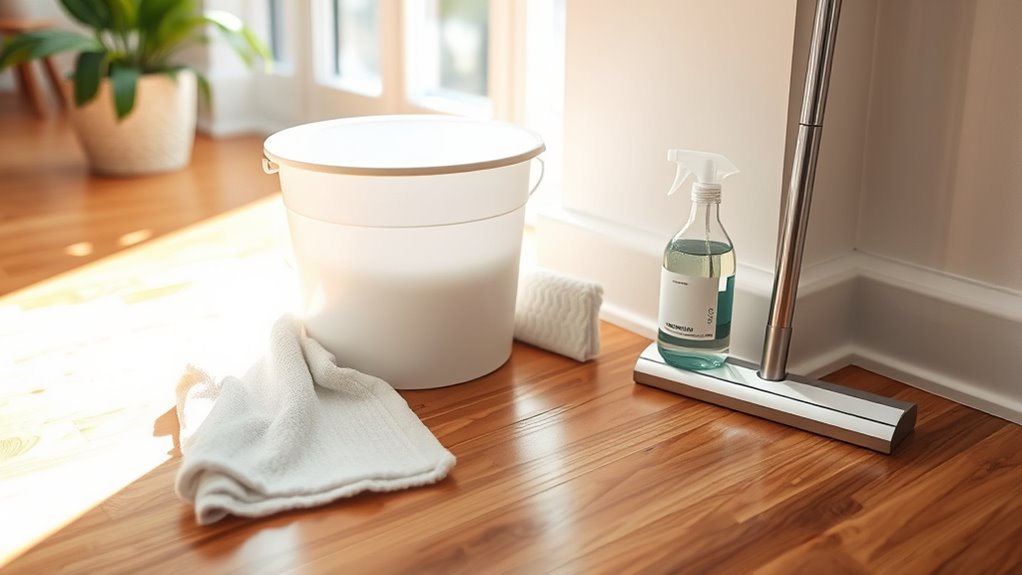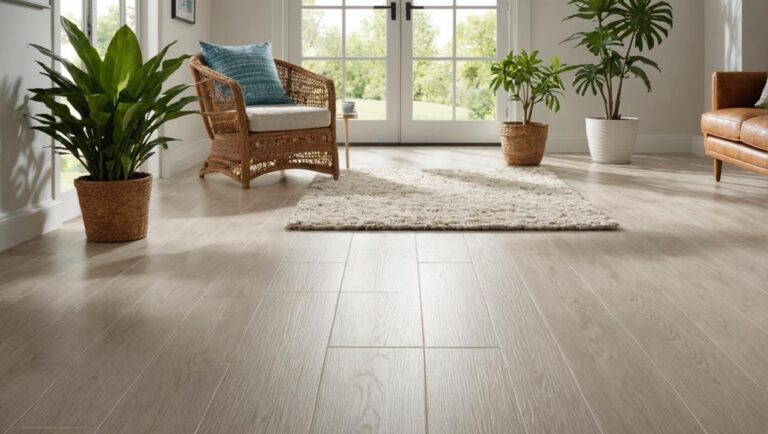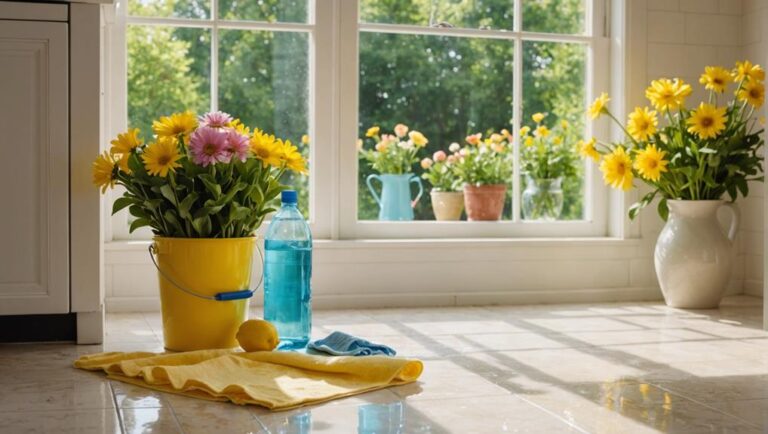First, check your floor for sticky spots and gather gentle cleaning supplies like a microfiber mop and pH-neutral cleaner. Clear the area and sweep or vacuum to remove dirt. Mix mild soap with water and gently scrub sticky areas, avoiding excess water. Rinse with a damp mop and dry quickly to protect the wood. For tough residue, natural solutions like diluted vinegar and baking soda help. Keep going, and you’ll discover detailed tips for long-lasting results.
Assessing the Severity of Stickiness on Wood Floors
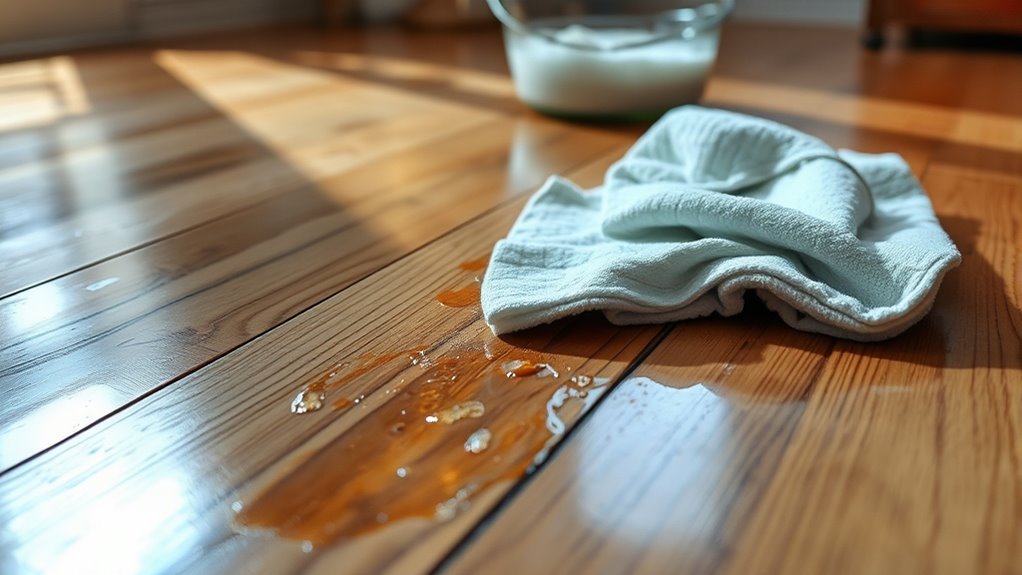
How sticky is your wood vloer, really? To accurately assess, start by running your hand gently over the surface. If you feel tackiness or notice dirt clinging, sticky residue causes may be at play—often due to spilled sugary substances or inadequate floor cleaning frequency. Evaluate the size and location of sticky patches; isolated spots suggest recent spills, while widespread stickiness points to deeper issues like accumulated grime. Understanding this helps you determine the cleaning intensity needed. Keeping track of how often you clean your floors directly impacts stickiness levels, so consider if your current routine allows residue buildup. A precise assessment guarantees you choose the right cleaning method, freeing you from persistent stickiness without unnecessary effort or damage to your wood floors.
Gathering Essential Cleaning Supplies
Before tackling sticky wood floors, you’ll need to gather specific cleaning supplies that effectively remove residue without damaging the surface. Start with essential tools like a soft microfiber mop or cloths, a bucket, and a gentle scrub brush for stubborn spots. Choose cleaning solutions formulated for wood floors—preferably pH-neutral and free from harsh chemicals to maintain the finish. Avoid abrasive cleaners or excessive water, as these can harm the wood. Having a spray bottle handy allows controlled application of your cleaning solution. Additionally, keep a dry towel nearby to promptly wipe excess moisture. By selecting the right essential tools and cleaning solutions, you set the stage for a safe and efficient cleaning process, freeing your floors from stickiness while preserving their natural beauty.
Preparing the Floor for Cleaning
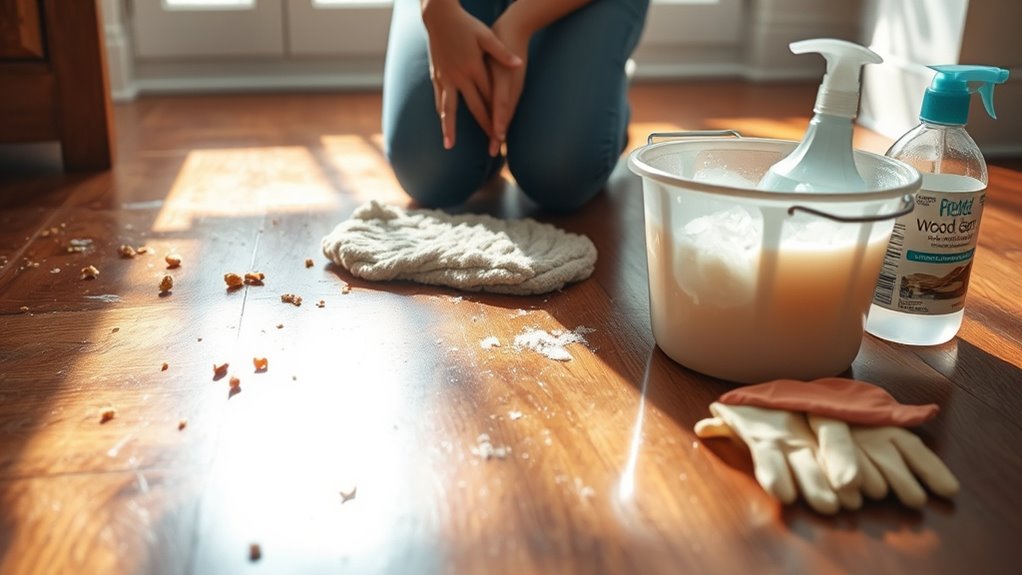
Once you’ve gathered your supplies, you’ll want to clear the floor of any dust, dirt, or debris that could interfere with the cleaning process. Proper floor preparation guarantees your cleaning materials work effectively without causing damage. Start by removing furniture or obstacles, allowing full access to the wood surface. Check your cleaning materials to confirm they’re suitable for wood floors and won’t leave residues.
| Stap | Actie |
|---|---|
| 1. Clear Obstacles | Move furniture and rugs |
| 2. Inspect Floor | Identify sticky or damaged spots |
| 3. Select Materials | Choose wood-safe cleaners |
| 4. Ventilate Area | Open windows for airflow |
This methodical approach sets a foundation for freedom from sticky residues, enabling your wood floor to shine cleanly and safely.
Removing Loose Dirt and Debris
Before tackling sticky residue, start by removing loose dirt and debris to prevent scratching your wood floors. Use a broom with soft bristles to sweep in gentle, even strokes, reaching corners and edges thoroughly. Alternatively, a vacuum with a hardwood floor setting can efficiently pick up dust without damaging the surface.
Sweeping Techniques
Although it might seem simple, effective sweeping is essential for removing loose dirt and debris that can cause your wood floors to feel sticky. Mastering proper sweeping techniques guarantees your floors stay clean without damage. Here’s how to make the most of your effective broom:
- Choose the right broom: Opt for a soft-bristle broom designed specifically for wood floors to avoid scratches.
- Sweep in sections: Divide your floor into manageable areas, sweeping each thoroughly to prevent dirt buildup.
- Use smooth, controlled strokes: Push debris gently toward one spot, avoiding harsh movements that might scatter dirt or damage the finish.
Vacuuming Tips
Vacuuming is an essential step for removing loose dirt and debris that sweeping might miss, especially in corners and along baseboards. To maintain the freedom of a clean, sticky-free wood floor, focus on effective vacuuming techniques. Use a vacuum with a hardwood floor setting or a soft brush attachment to avoid scratches. Move the vacuum slowly and methodically, ensuring all debris is lifted without damaging the wood. Pay special attention to edges and high-traffic areas where dirt accumulates. Regarding vacuuming frequency, aim to vacuum at least twice a week or more if you have pets or heavy foot traffic. Regular vacuuming prevents buildup and makes subsequent cleaning easier, preserving your floor’s beauty and your freedom to enjoy a spotless home.
Mixing a Gentle Cleaning Solution
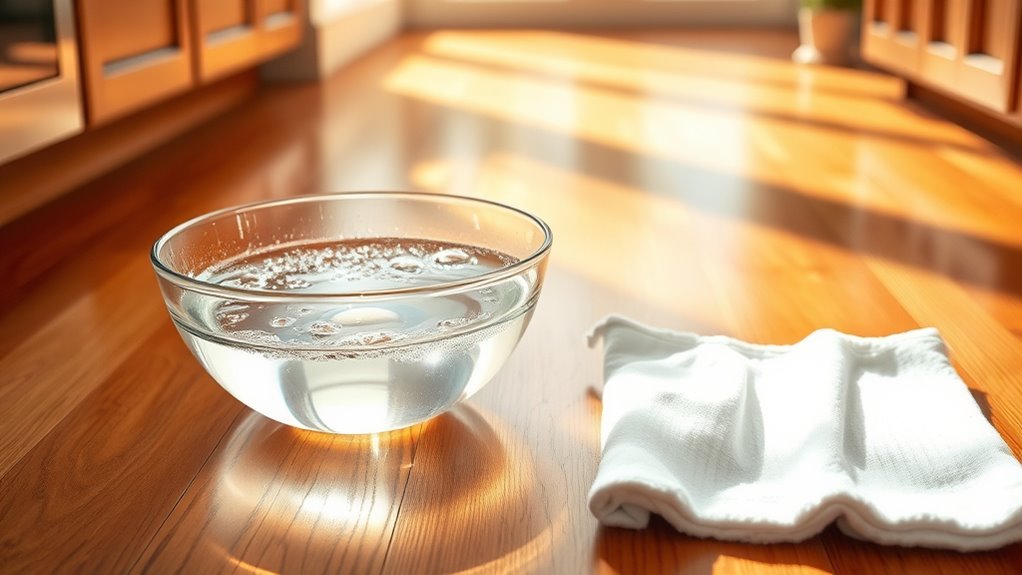
You’ll want to select cleaning ingredients that are safe for wood, avoiding harsh chemicals that can damage the finish. Mix your solution using the proper dilution ratios to guarantee it’s effective without being too strong. This balance helps protect your floors while removing sticky residue efficiently.
Choosing Safe Cleaning Ingredients
A gentle cleaning solution is essential for preserving your wood floors while effectively removing stickiness. When choosing ingredients, focus on eco friendly options and safe alternatives that won’t damage the finish or harm your indoor air quality. Consider these three key points:
- Use mild dish soap or castile soap diluted in water — both are biodegradable and gentle on wood.
- Avoid harsh chemicals like ammonia or bleach; they can strip protective coatings and cause discoloration.
- Incorporate natural ingredients like white vinegar sparingly, as it cleans well but can be acidic if overused.
Proper Dilution Ratios
Three simple ratios can help you mix an effective cleaning solution without risking damage to your wood floors. Start by diluting gentle cleaning concentrates with water at a 1:10 ratio—one part concentrate to ten parts water—for everyday cleaning. For sticky spots, increase strength slightly to 1:5, ensuring the solution remains mild enough to protect the finish. Never use undiluted concentrates, as they can strip or dull your floor’s surface. Always measure carefully to maintain consistent dilution ratios; this precision preserves your floors’ natural beauty and extends their lifespan. By mastering these ratios, you gain control over cleaning power without compromising safety. Remember, proper dilution means freedom from residue and damage, letting your wood floors stay clean, smooth, and inviting.
Applying the Cleaning Solution Correctly
Before applying the cleaning solution, make sure the floor is free of loose dirt and debris by sweeping or vacuuming thoroughly. This step guarantees your cleaning techniques are effective and protects floor safety by preventing scratches from particles. When ready, apply the solution carefully:
- Lightly dampen a microfiber mop or cloth with the diluted cleaner to avoid excess moisture.
- Work in small sections, moving with the wood grain to maximize cleaning impact and minimize streaks.
- Rinse and wring your mop frequently to prevent redistributing dirt.
Scrubbing Sticky Spots With Care
When tackling sticky spots on your wood floors, it’s important to apply gentle pressure with a soft-bristled brush or non-abrasive pad to avoid damaging the finish. Use gentle scrubbing techniques focused on sticky residue removal, working in small, circular motions. Avoid harsh tools that can scratch or dull the surface. Here’s a quick guide:
| Tool | Doel |
|---|---|
| Soft-bristled brush | Loosen sticky residue |
| Non-abrasive pad | Gentle scrubbing |
| Mild cleaning solution | Dissolve sticky buildup |
| Microfiber cloth | Wipe away loosened dirt |
Rinsing and Drying the Floor Thoroughly
Although you’ve loosened and scrubbed the sticky residue, rinsing and drying your wood floor thoroughly is crucial to prevent moisture damage and residue buildup. To guarantee your floor stays pristine, follow these rinsing techniques and drying methods:
- Use a damp microfiber mop with clean water to gently rinse away any cleaning solution, avoiding oversaturation.
- Immediately after rinsing, dry the floor with a clean, absorbent towel or microfiber cloth to remove excess moisture.
- Improve air circulation by opening windows or using fans to speed up the drying process, preventing water from seeping into the wood.
Using Natural Remedies for Tough Residues
Two natural remedies stand out for tackling tough sticky residues on wood floors: vinegar and baking soda. Start by mixing one cup of white vinegar with a gallon of warm water for a gentle natural cleaning solution. Use a soft cloth to apply it, scrubbing sticky spots carefully to avoid damage. For more stubborn residues, sprinkle baking soda directly onto the sticky area, then dampen a soft cloth with water and gently rub in a circular motion. This homemade solution acts as a mild abrasive, lifting residue without harsh chemicals. Always rinse the floor with clean water afterward to remove any leftover solution, then dry thoroughly. These natural cleaning methods give you effective, eco-friendly options to restore your wood floors’ smooth finish without sacrificing your desire for freedom from toxins.
Preventing Future Stickiness on Wood Floors
To keep your wood floors from becoming sticky again, start by placing protective mats in high-traffic and spill-prone areas. Establish a regular cleaning routine using appropriate wood floor cleaners to remove dirt and residue before it builds up. Consistency in these practices will help maintain the floor’s smooth, clean surface over time.
Use Protective Floor Mats
Since sticky residue often accumulates in high-traffic areas, using protective floor mats is an effective way to prevent future stickiness on wood floors. Protective mats act as barriers, catching dirt, spills, and moisture before they reach your wood surface. To optimize floor maintenance, consider these steps:
- Place mats at entrances and near sinks or dining areas to trap debris early.
- Choose mats with non-slip backing to avoid movement that can scratch floors.
- Regularly clean and replace mats to prevent buildup that could transfer to your wood floors.
Regelmatige schoonmaakroutine
Although protecting your wood floors with mats is important, maintaining a regular cleaning routine is crucial to prevent sticky buildup. Regular maintenance guarantees dirt, spills, and residues don’t settle and cause tackiness. You should sweep or vacuum daily to remove dust and debris that can trap moisture. For cleaning frequency, mop your floors with a damp, well-wrung microfiber mop at least once a week, using a cleaner specifically designed for wood floors. Avoid over-wetting the surface, as excess water can damage wood. Address spills immediately to prevent sticky patches from forming. By sticking to this methodical cleaning schedule, you’ll keep your floors smooth and residue-free, giving you the freedom to enjoy your space without worrying about sticky, uncomfortable surfaces.

